instrument panel Abarth 500 2020 Owner handbook (in English)
[x] Cancel search | Manufacturer: ABARTH, Model Year: 2020, Model line: 500, Model: Abarth 500 2020Pages: 196, PDF Size: 3.53 MB
Page 48 of 196
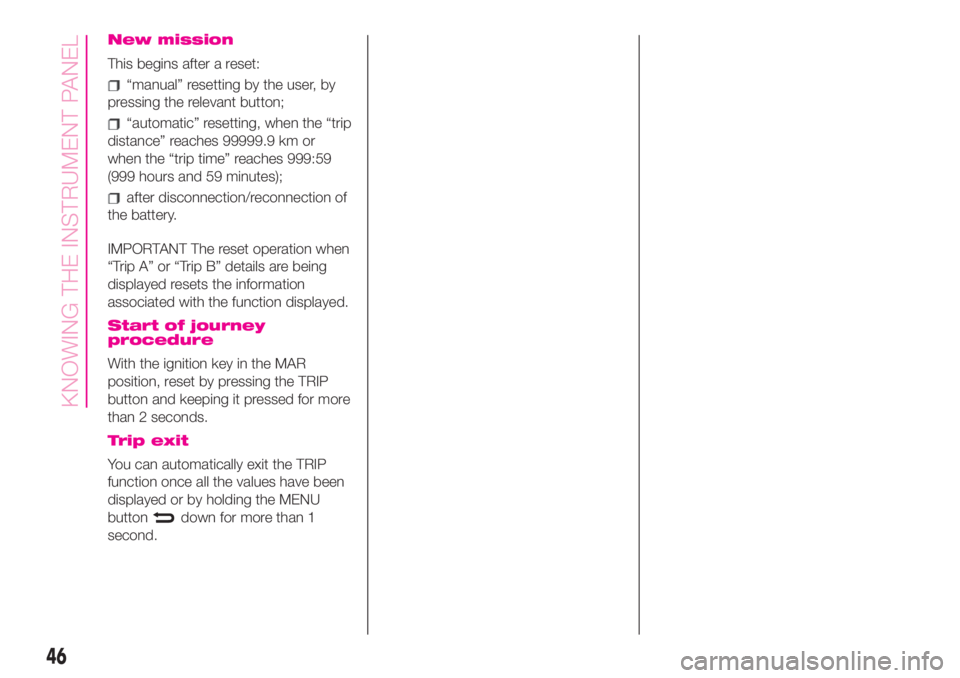
New mission
This begins after a reset:
“manual” resetting by the user, by
pressing the relevant button;
“automatic” resetting, when the “trip
distance” reaches 99999.9 km or
when the “trip time” reaches 999:59
(999 hours and 59 minutes);
after disconnection/reconnection of
the battery.
IMPORTANT The reset operation when
“Trip A” or “Trip B” details are being
displayed resets the information
associated with the function displayed.
Start of journey
procedure
With the ignition key in the MAR
position, reset by pressing the TRIP
button and keeping it pressed for more
than 2 seconds.
Trip exit
You can automatically exit the TRIP
function once all the values have been
displayed or by holding the MENU
button
down for more than 1
second.
46
KNOWING THE INSTRUMENT PANEL
Page 49 of 196
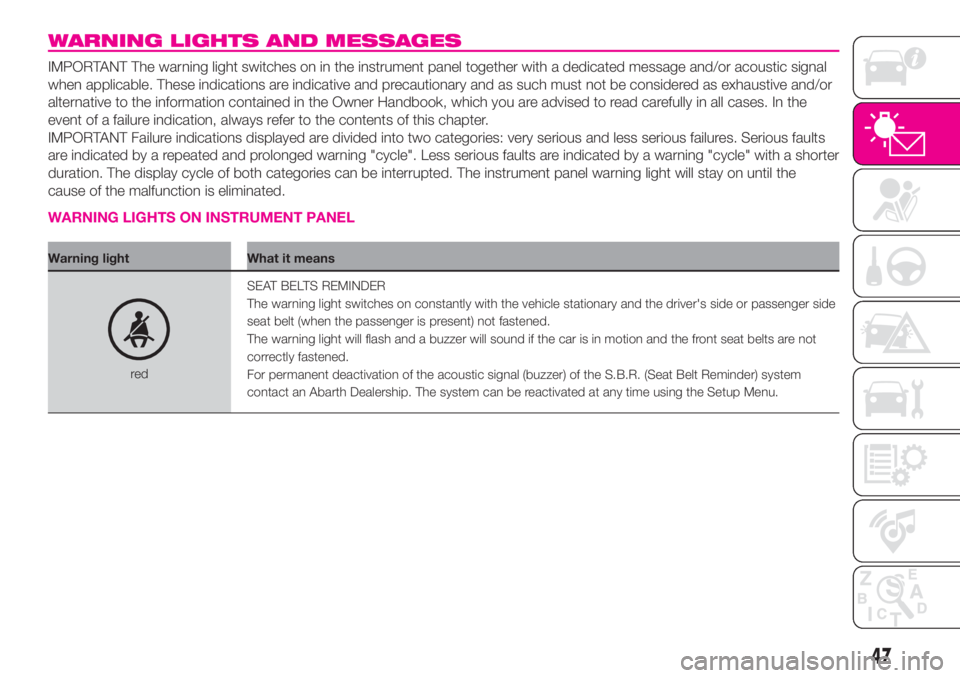
WARNING LIGHTS AND MESSAGES
IMPORTANT The warning light switches on in the instrument panel together with a dedicated message and/or acoustic signal
when applicable. These indications are indicative and precautionary and as such must not be considered as exhaustive and/or
alternative to the information contained in the Owner Handbook, which you are advised to read carefully in all cases. In the
event of a failure indication, always refer to the contents of this chapter.
IMPORTANT Failure indications displayed are divided into two categories: very serious and less serious failures. Serious faults
are indicated by a repeated and prolonged warning "cycle". Less serious faults are indicated by a warning "cycle" with a shorter
duration. The display cycle of both categories can be interrupted. The instrument panel warning light will stay on until the
cause of the malfunction is eliminated.
WARNING LIGHTS ON INSTRUMENT PANEL
Warning light What it means
redSEAT BELTS REMINDER
The warning light switches on constantly with the vehicle stationary and the driver's side or passenger side
seat belt (when the passenger is present) not fastened.
The warning light will flash and a buzzer will sound if the car is in motion and the front seat belts are not
correctly fastened.
For permanent deactivation of the acoustic signal (buzzer) of the S.B.R. (Seat Belt Reminder) system
contact an Abarth Dealership. The system can be reactivated at any time using the Setup Menu.
47
Page 50 of 196
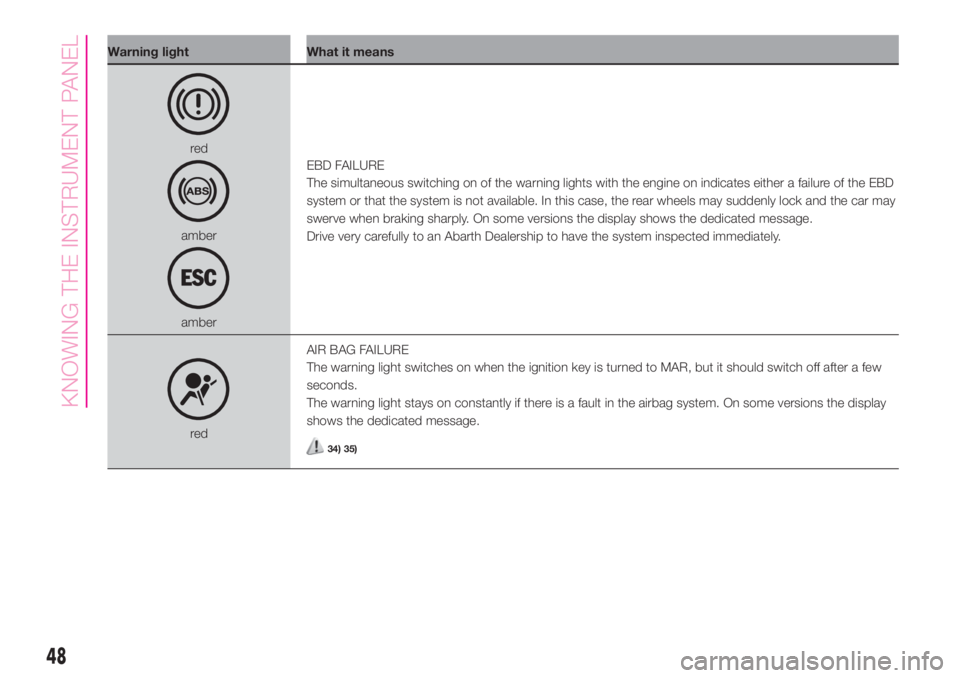
Warning light What it means
red
amber
amberEBD FAILURE
The simultaneous switching on of the warning lights with the engine on indicates either a failure of the EBD
system or that the system is not available. In this case, the rear wheels may suddenly lock and the car may
swerve when braking sharply. On some versions the display shows the dedicated message.
Drive very carefully to an Abarth Dealership to have the system inspected immediately.
redAIR BAG FAILURE
The warning light switches on when the ignition key is turned to MAR, but it should switch off after a few
seconds.
The warning light stays on constantly if there is a fault in the airbag system. On some versions the display
shows the dedicated message.34) 35)
48
KNOWING THE INSTRUMENT PANEL
Page 51 of 196
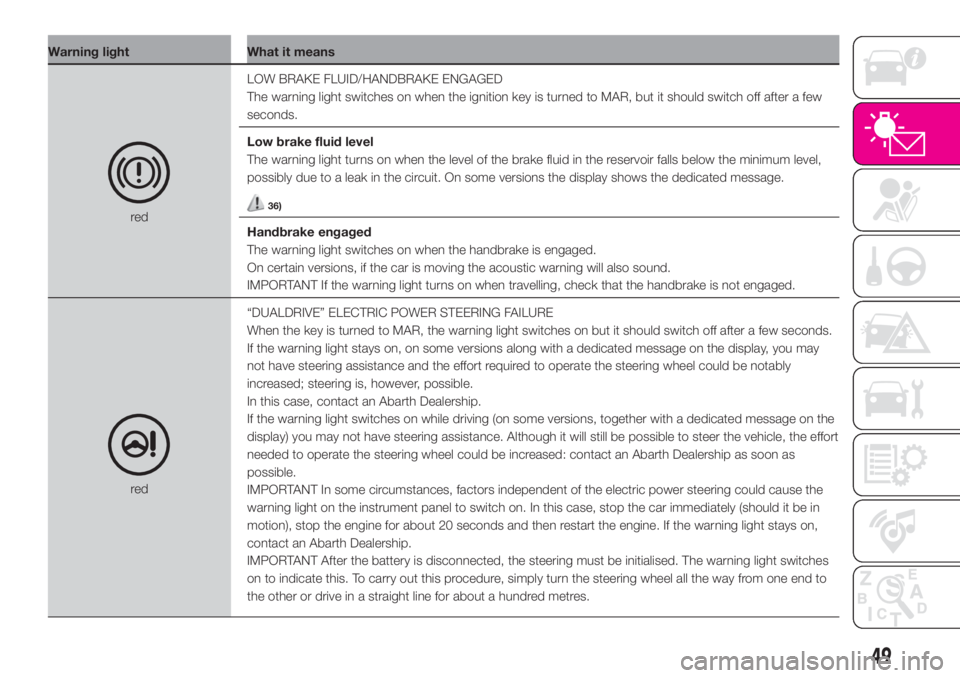
Warning light What it means
redLOW BRAKE FLUID/HANDBRAKE ENGAGED
The warning light switches on when the ignition key is turned to MAR, but it should switch off after a few
seconds.
Low brake fluid level
The warning light turns on when the level of the brake fluid in the reservoir falls below the minimum level,
possibly due to a leak in the circuit. On some versions the display shows the dedicated message.36)
Handbrake engaged
The warning light switches on when the handbrake is engaged.
On certain versions, if the car is moving the acoustic warning will also sound.
IMPORTANT If the warning light turns on when travelling, check that the handbrake is not engaged.
red“DUALDRIVE” ELECTRIC POWER STEERING FAILURE
When the key is turned to MAR, the warning light switches on but it should switch off after a few seconds.
If the warning light stays on, on some versions along with a dedicated message on the display, you may
not have steering assistance and the effort required to operate the steering wheel could be notably
increased; steering is, however, possible.
In this case, contact an Abarth Dealership.
If the warning light switches on while driving (on some versions, together with a dedicated message on the
display) you may not have steering assistance. Although it will still be possible to steer the vehicle, the effort
needed to operate the steering wheel could be increased: contact an Abarth Dealership as soon as
possible.
IMPORTANT In some circumstances, factors independent of the electric power steering could cause the
warning light on the instrument panel to switch on. In this case, stop the car immediately (should it be in
motion), stop the engine for about 20 seconds and then restart the engine. If the warning light stays on,
contact an Abarth Dealership.
IMPORTANT After the battery is disconnected, the steering must be initialised. The warning light switches
on to indicate this. To carry out this procedure, simply turn the steering wheel all the way from one end to
the other or drive in a straight line for about a hundred metres.
49
Page 52 of 196
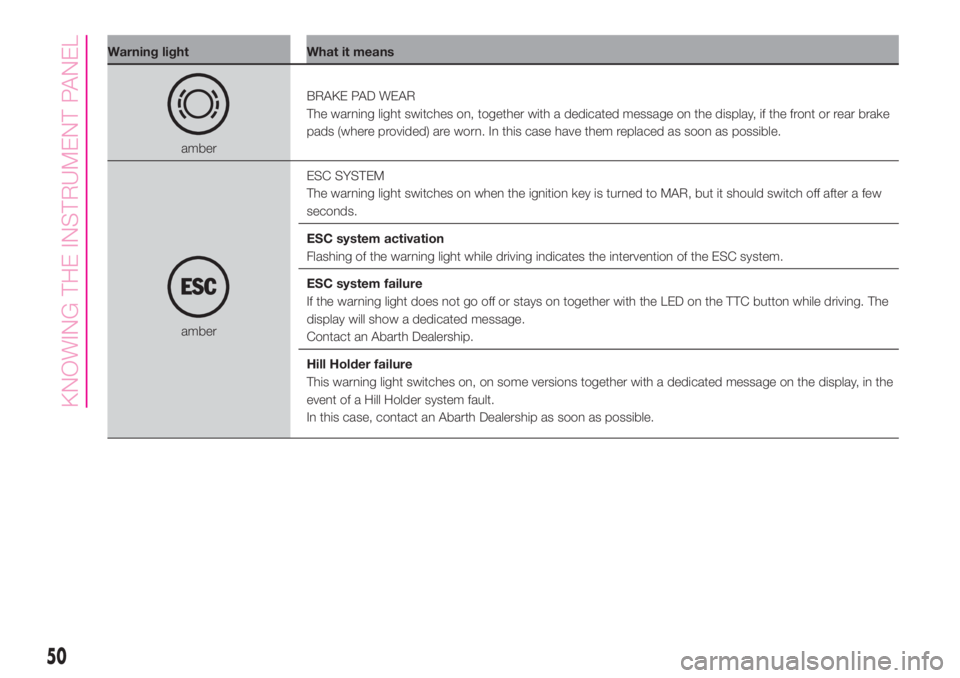
Warning light What it means
amberBRAKE PAD WEAR
The warning light switches on, together with a dedicated message on the display, if the front or rear brake
pads (where provided) are worn. In this case have them replaced as soon as possible.
amberESC SYSTEM
The warning light switches on when the ignition key is turned to MAR, but it should switch off after a few
seconds.
ESC system activation
Flashing of the warning light while driving indicates the intervention of the ESC system.
ESC system failure
If the warning light does not go off or stays on together with the LED on the TTC button while driving. The
display will show a dedicated message.
Contact an Abarth Dealership.
Hill Holder failure
This warning light switches on, on some versions together with a dedicated message on the display, in the
event of a Hill Holder system fault.
In this case, contact an Abarth Dealership as soon as possible.
50
KNOWING THE INSTRUMENT PANEL
Page 54 of 196
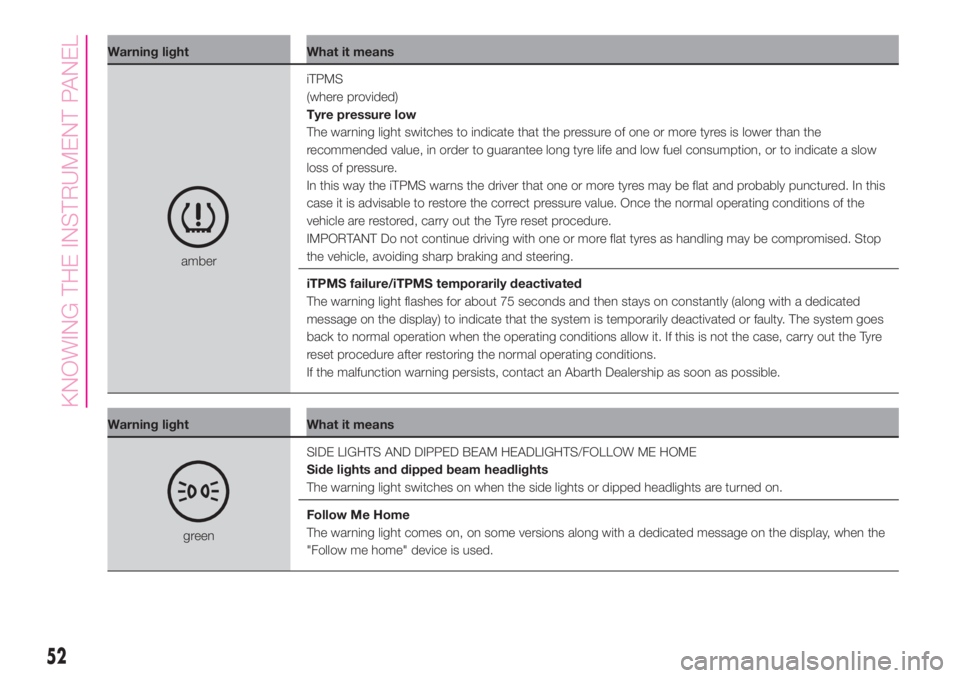
Warning light What it means
amberiTPMS
(where provided)
Tyre pressure low
The warning light switches to indicate that the pressure of one or more tyres is lower than the
recommended value, in order to guarantee long tyre life and low fuel consumption, or to indicate a slow
loss of pressure.
In this way the iTPMS warns the driver that one or more tyres may be flat and probably punctured. In this
case it is advisable to restore the correct pressure value. Once the normal operating conditions of the
vehicle are restored, carry out the Tyre reset procedure.
IMPORTANT Do not continue driving with one or more flat tyres as handling may be compromised. Stop
the vehicle, avoiding sharp braking and steering.
iTPMS failure/iTPMS temporarily deactivated
The warning light flashes for about 75 seconds and then stays on constantly (along with a dedicated
message on the display) to indicate that the system is temporarily deactivated or faulty. The system goes
back to normal operation when the operating conditions allow it. If this is not the case, carry out the Tyre
reset procedure after restoring the normal operating conditions.
If the malfunction warning persists, contact an Abarth Dealership as soon as possible.
Warning light What it means
greenSIDE LIGHTS AND DIPPED BEAM HEADLIGHTS/FOLLOW ME HOME
Side lights and dipped beam headlights
The warning light switches on when the side lights or dipped headlights are turned on.
Follow Me Home
The warning light comes on, on some versions along with a dedicated message on the display, when the
"Follow me home" device is used.
52
KNOWING THE INSTRUMENT PANEL
Page 56 of 196
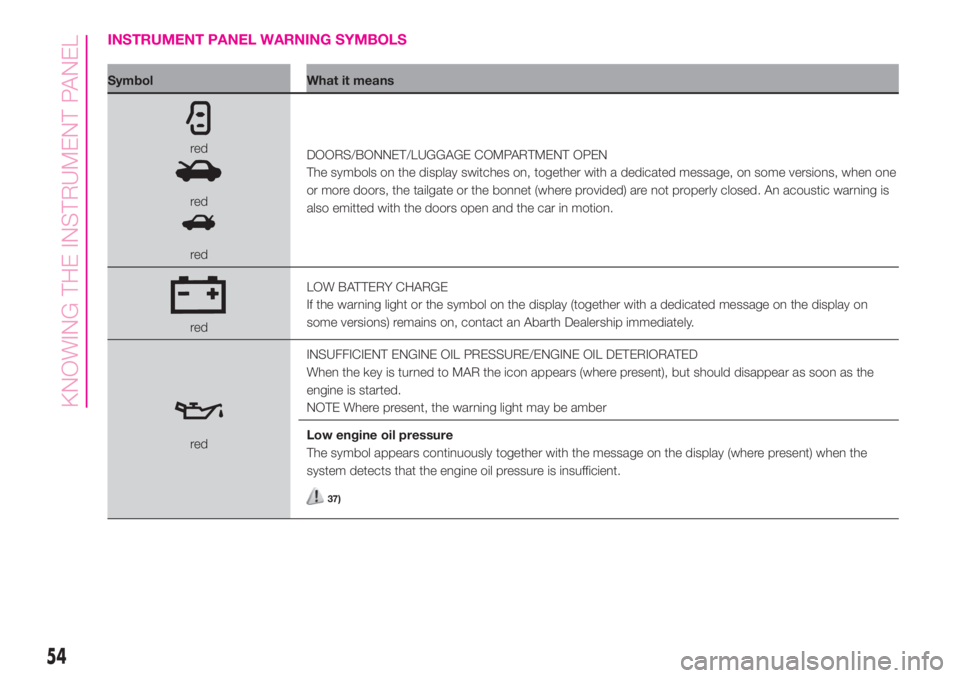
INSTRUMENT PANEL WARNING SYMBOLS
Symbol What it means
red
red
redDOORS/BONNET/LUGGAGE COMPARTMENT OPEN
The symbols on the display switches on, together with a dedicated message, on some versions, when one
or more doors, the tailgate or the bonnet (where provided) are not properly closed. An acoustic warning is
also emitted with the doors open and the car in motion.
redLOW BATTERY CHARGE
If the warning light or the symbol on the display (together with a dedicated message on the display on
some versions) remains on, contact an Abarth Dealership immediately.
redINSUFFICIENT ENGINE OIL PRESSURE/ENGINE OIL DETERIORATED
When the key is turned to MAR the icon appears (where present), but should disappear as soon as the
engine is started.
NOTE Where present, the warning light may be amber
Low engine oil pressure
The symbol appears continuously together with the message on the display (where present) when the
system detects that the engine oil pressure is insufficient.
37)
54
KNOWING THE INSTRUMENT PANEL
Page 58 of 196

Symbol What it means
amberPOSSIBLE ICE ON ROAD
The symbol is displayed when the outside temperature falls to or below 3°C.
On some versions the display shows the dedicated message.
amberPARKING SENSOR FAILURE
(where provided)
The symbol is shown on the display together with a dedicated message if there is a fault in the parking
sensors.
amberSERVICE (SCHEDULED SERVICING) EXPIRED
When the scheduled servicing is nearly due ("scheduled service deadline"), the display will show the
symbol followed by the number of kilometres/miles until the car must be serviced. This is displayed
automatically, with ignition key at MAR, 2000 km (or equivalent value in miles) before servicing or, for some
markets, 30 days before servicing. It is also displayed each time the key is turned to MAR or, for some
markets, every 200 km (or equivalent value in miles).
Go to an Abarth Dealership, where the "Service Schedule" operations will be performed and the message
will be reset.
amberASR SYSTEM
On some versions, the display will the show symbol together with a dedicated message on the display,
when the ASR system is deactivated.
amberHILL HOLDER FAILURE
(where provided)
The display will show the symbol together with a dedicated message when there is a fault in the Hill Holder
system.
In this case, contact an Abarth Dealership as soon as possible.
amberFUEL CUT-OFF SYSTEM
The display will show the symbol and a dedicated message if the fuel cut-off system intervenes.
For the fuel cut-off system re-activation procedure, see the "Fuel cut-off system" paragraph, in the "In an
emergency" chapter.
56
KNOWING THE INSTRUMENT PANEL
Page 60 of 196
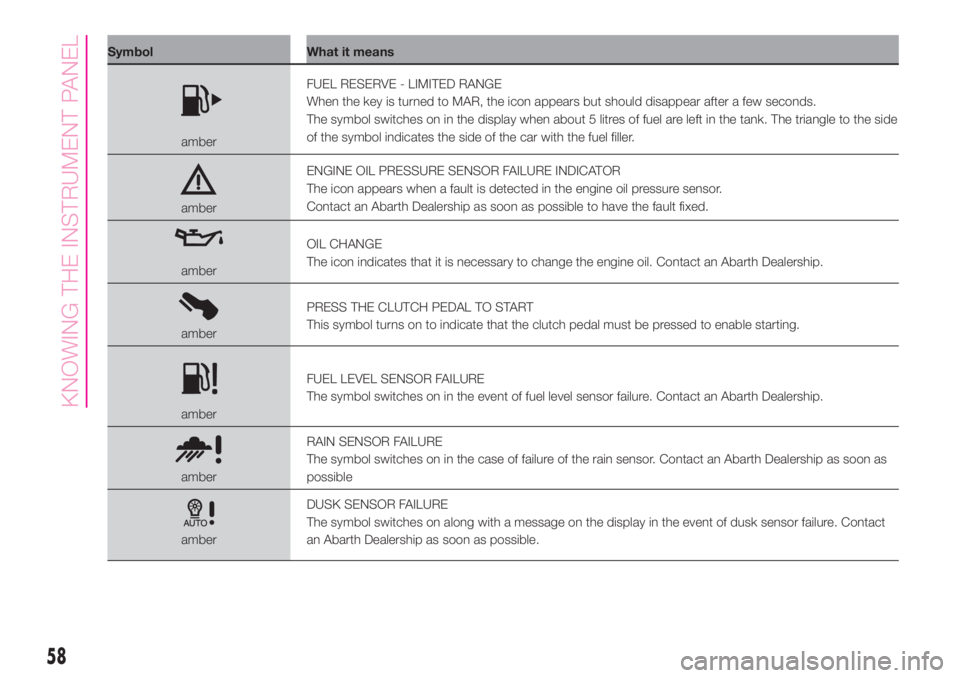
Symbol What it means
amberFUEL RESERVE - LIMITED RANGE
When the key is turned to MAR, the icon appears but should disappear after a few seconds.
The symbol switches on in the display when about 5 litres of fuel are left in the tank. The triangle to the side
of the symbol indicates the side of the car with the fuel filler.
amberENGINE OIL PRESSURE SENSOR FAILURE INDICATOR
The icon appears when a fault is detected in the engine oil pressure sensor.
Contact an Abarth Dealership as soon as possible to have the fault fixed.
amberOIL CHANGE
The icon indicates that it is necessary to change the engine oil. Contact an Abarth Dealership.
amberPRESS THE CLUTCH PEDAL TO START
This symbol turns on to indicate that the clutch pedal must be pressed to enable starting.
amberFUEL LEVEL SENSOR FAILURE
The symbol switches on in the event of fuel level sensor failure. Contact an Abarth Dealership.
amberRAIN SENSOR FAILURE
The symbol switches on in the case of failure of the rain sensor. Contact an Abarth Dealership as soon as
possible
amberDUSK SENSOR FAILURE
The symbol switches on along with a message on the display in the event of dusk sensor failure. Contact
an Abarth Dealership as soon as possible.
58
KNOWING THE INSTRUMENT PANEL
Page 63 of 196
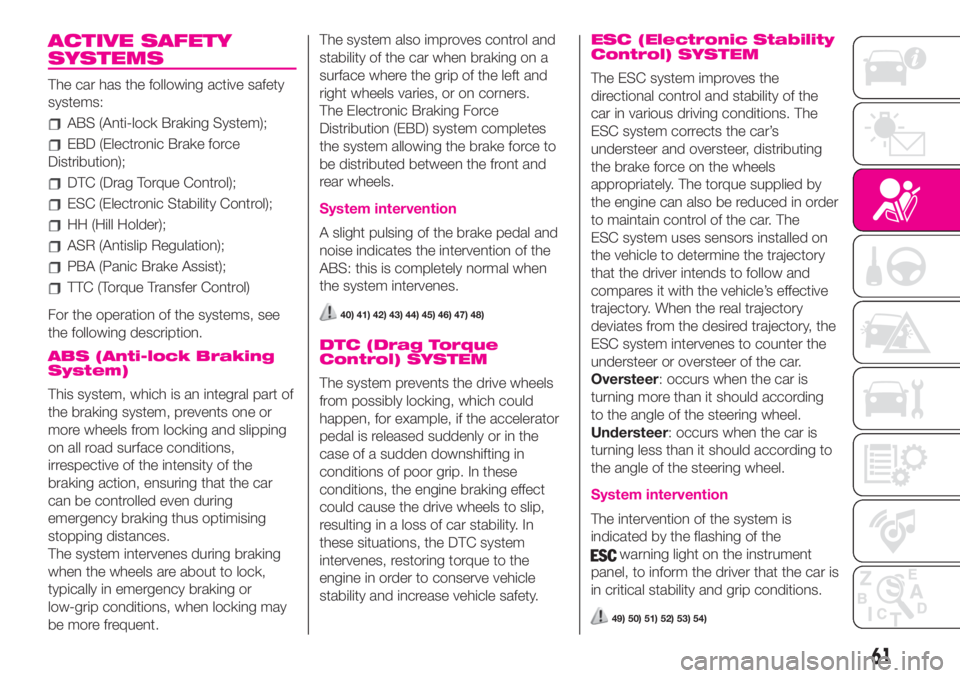
ACTIVE SAFETY
SYSTEMS
The car has the following active safety
systems:
ABS (Anti-lock Braking System);
EBD (Electronic Brake force
Distribution);
DTC (Drag Torque Control);
ESC (Electronic Stability Control);
HH (Hill Holder);
ASR (Antislip Regulation);
PBA (Panic Brake Assist);
TTC (Torque Transfer Control)
For the operation of the systems, see
the following description.
ABS (Anti-lock Braking
System)
This system, which is an integral part of
the braking system, prevents one or
more wheels from locking and slipping
on all road surface conditions,
irrespective of the intensity of the
braking action, ensuring that the car
can be controlled even during
emergency braking thus optimising
stopping distances.
The system intervenes during braking
when the wheels are about to lock,
typically in emergency braking or
low-grip conditions, when locking may
be more frequent.The system also improves control and
stability of the car when braking on a
surface where the grip of the left and
right wheels varies, or on corners.
The Electronic Braking Force
Distribution (EBD) system completes
the system allowing the brake force to
be distributed between the front and
rear wheels.
System intervention
A slight pulsing of the brake pedal and
noise indicates the intervention of the
ABS: this is completely normal when
the system intervenes.
40) 41) 42) 43) 44) 45) 46) 47) 48)
DTC (Drag Torque
Control) SYSTEM
The system prevents the drive wheels
from possibly locking, which could
happen, for example, if the accelerator
pedal is released suddenly or in the
case of a sudden downshifting in
conditions of poor grip. In these
conditions, the engine braking effect
could cause the drive wheels to slip,
resulting in a loss of car stability. In
these situations, the DTC system
intervenes, restoring torque to the
engine in order to conserve vehicle
stability and increase vehicle safety.
ESC (Electronic Stability
Control) SYSTEM
The ESC system improves the
directional control and stability of the
car in various driving conditions. The
ESC system corrects the car’s
understeer and oversteer, distributing
the brake force on the wheels
appropriately. The torque supplied by
the engine can also be reduced in order
to maintain control of the car. The
ESC system uses sensors installed on
the vehicle to determine the trajectory
that the driver intends to follow and
compares it with the vehicle’s effective
trajectory. When the real trajectory
deviates from the desired trajectory, the
ESC system intervenes to counter the
understeer or oversteer of the car.
Oversteer: occurs when the car is
turning more than it should according
to the angle of the steering wheel.
Understeer: occurs when the car is
turning less than it should according to
the angle of the steering wheel.
System intervention
The intervention of the system is
indicated by the flashing of the
warning light on the instrument
panel, to inform the driver that the car is
in critical stability and grip conditions.
49) 50) 51) 52) 53) 54)
61